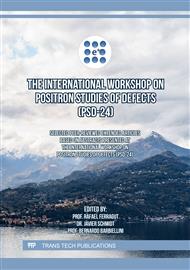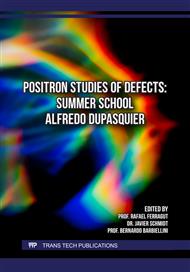[1]
M. Wenskat et al., Vacancy-Hydrogen Interaction in Niobium during Low-Temperature Baking, Scientific Reports 10 (2020) 8300
DOI: 10.1038/s41598-020-65083-0
Google Scholar
[2]
L. Chiari, et al, Formation and time dynamics of hydrogen-induced vacancies in nickel, Acta Materialia 219 (2021) 117264
DOI: 10.1016/j.actamat.2021.117264
Google Scholar
[3]
D.B. Cassidy, et al., Positron beam production with a deuteron accelerator, Nucl. Instr. Meth. B 195 (2002) 442-448
Google Scholar
[4]
R. Xie, et al., Production of a low energy positron beam using the 12C(d,n)13N reaction, Nucl. Instr. Meth. B 195 (1993) 98-102
Google Scholar
[5]
Experimental Nuclear Reaction Data (EXFOR) Database: https://www-nds.iaea.org/exfor/
Google Scholar
[6]
R. H. Howell, et al., Production and Use of Low-Energy, Monoenergetic Positron Beams from Electron LINACS, Appl. Phys. A 43 (1987) 247-255
DOI: 10.1007/bf00635179
Google Scholar
[7]
F. Ebel, et al., Production of Slow Positrons with the Giessen 65 MeV LINAC, Appl. Phys. A 44 (1987) 119-121
DOI: 10.1007/bf00626411
Google Scholar
[8]
T. Akahane, et al., Stretching of Slow Positron Pulses Generated with an Electron Linac, Appl. Phys. A 51 (1990) 146-150
DOI: 10.1007/bf00324279
Google Scholar
[9]
D. Segers, et al., Creation of slow positrons at the Ghent 90 MeV linac, Nucl. Instr. Meth. B 56/57 (1991) 572-574
DOI: 10.1016/0168-583x(91)96098-6
Google Scholar
[10]
A. Wagner, et al., Positron annihilation lifetime and Doppler broadening spectroscopy at the ELBE facility, AIP Conf. Proc. 1970 (2018) 040003
DOI: 10.1063/1.5040215
Google Scholar
[11]
P. F. Paradis, et al., Thermophysical Properties of Molten Tungsten Measured with an Electrostatic Levitator, Heat Transfer – Asian Research 35 (2006) 152-164
DOI: 10.1002/htj.20101
Google Scholar
[12]
M. Maekawa, et al., Development of spin-polarized slow positron beam using a 68Ge–68Ga positron source, Nucl. Instr. Meth. B 308 (2013) 9-14
DOI: 10.1016/j.nimb.2013.04.015
Google Scholar
[13]
D. Abbott et al. (PEPPo Collaboration), Production of Highly Polarized Positrons Using Polarized Electrons at MeV Energies, Phys. Rev. Lett. 116 (2016) 214801
Google Scholar
[14]
G4beamline. https://www.muonsinc.com/Website1/G4beamline
Google Scholar
[15]
S. Agostinelli, et al., Geant4—a simulation toolkit, Nucl. Instr. Meth. A 506 (2003) 250-303, https://geant4.web.cern.ch/; https://geant4.web.cern.ch/
Google Scholar
[16]
J. Allison, et al., Recent developments in Geant4, Nucl. Instr. Meth. A 835 (2016) 186-225
Google Scholar



